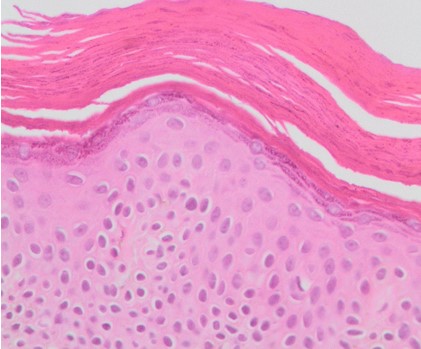Abstract
The Intestinal tuberculosis (ITB) and Crohn’s disease (CD) are chronic granulomatous disorders, that could have a transmural compromiso. They can affect any part of the digestive system. Both have similar symptoms looking at them from a clinical, radiological, endoscopical and histological point of view.
I presented two cases of patients where the initial suggestive diagnosis was Crohn’s disease. Confirmed with ileocolonic involvement based on clinical data, endoscopical, serological and histological findings.
However, patients had a poor clinical response to the conventional therapies used in the treatment of CD, even with the implementation of steroids. At the begining , in both cases is descarted systemic infectios. Patients started inmunosuppressive therapies with the use of azathioprine and antibodies against tumor necrosis factor alpha (TNFa inhibitor). As a result, the patients developed disseminated forms of the tuberculosis. They did not show improvement of the gastrointestinal symptoms. But, they had a satisfactory response with respect to the infectios and digestive symptoms, when they used the antituberculous. The conclusion was, a diagnosis of intestinal tuberculosis mimicking Crohn’s disease.
2. Epstein D, Watermeyer G, Kiresh R. The diagnosis and management of Crohn‘s disease in populations with high risk rates of Tuberculosis. Aliment Pharmacol Ther 2007;25(12):1373-1388.
3. Anmad R, Shafique MS, Zafar S, Mehmood S, Mehmood S, Qureshi U, Khan JS. Intestinal tuberculosis; pattern of presentation and surgical management. Professional Med J 2016;23(11):1334-1339.
4. Mosquera-Klinger G, Ucroz A. Enfermedad de crohn vs tuberculosis intestinal: un diagnóstico diferencial desafiante. Rev Colomb Gastroenterol 2018;33(4):423-430.
5. Almadi MA, Ghosh S, Aljebreen AM. Differentiating intestinal tuberculosis from Crohn’s disease: a diagnostic challenge. Am J Gastroenterol. 2009;104(4):1003-1012.
6. Ma JY, Tong JL, Ran ZH. Intestinal tuberculosis and Crohn's disease: challenging differential diagnosis. Journal of digestive diseases 2016;17(3), 155-16.
7. Choi, E, Coyle, W. Gastrointestinal Tuberculosis. Microbiol spectrum 2016; 4(6):1-20.
8. DiLauro S, Crum-Cianflone N. Ileitis: When it is not Crohn’s disease. Curr Gastroenterol Rep 2010;12:249-258.
9. Jin T, Fei B, Zhang Y, He X. The diagnostic value of Polymerase chain reaction for Mycobacterium tuberculosis to distinguish intestinal Tuberculosis from Crohn’s disease: A Meta-Analysis. Saudi J Gastroenterol 2017;23:3‐10
10. Mouli VP, Munot K, Ananthakrishnan A, Kedia S, Addagalla S, Garg SK, Benjamin J, Singla V, Dhingra R, Tiwari V, Bopanna S, Hutfless S, Makharia G, Ahuja V. Endoscopic and clinical responses to anti-tubercular therapy can differentiate intestinal tuberculosis from Crohn’s disease. Aliment Pharmacol Ther 2017; 45: 27–36.
11. Wehkamp J, Stange FF. Paneth’s disease. J Crohns Colitis 2010; 4: 523–31
12. Naser SA, Ghobrial G, Romero C, Valentine JF. Culture of Mycobacterium avium subspecies paratuberculosis from the blood of patients with Crohn’s disease. Lancet 2004; 364: 1039–44.
13. Thomas DC. Cows, Crohn’s and more: is Mycobacterium paratuberculosis a superantigen? Med Hypotheses 2008; 71: 858–61.
14. Chamberlin W, Graham DY, Hulten K, El-Zimaity T, Schwartz MR, Naser S, Shafran I, El-Zaatari AK. Review article: Mycobacterium avium subsp. paratuberculosis as one cause of Crohn’s disease. Aliment Pharmacol Ther 2001; 15: 337–46.
15. Su C, Lichtenstein GR, Krok K, Brensinger CM, Lewis JD. A meta- analysis of the placebo rates of remission and response in clinical trials of active Crohn’s disease. Gastroenterology 2004; 126: 1257–69
16. McNees A, Markesich D, Zayyani N, et al. Expert Rev Gastroenterol Hepatol 2015;9(12):1523-1534. DOI:10.1586/17474124.2015.1093931.
17. Borgaonkar M, MacIntosh D, Fardy J, et al. Anti-tuberculous therapy for maintenance of remission in Crohn’s disease (review). Cochrane database of systematic reviews 1999;2(1-11). DOI:10.1002/14651858.CD000299.
18. Ooi CJ, Hilmi I, Makharia GK, Gibson PR, Fock KM, Ahuja V, Ling KL, Lim WC, Thia KT, Wei SC, Leung WK, Koh PK, Gearry RB, Goh KL, Ouyang Q, Sollano J, Manatsathit S, De Silva HJ, Rerknimitr R, Pisespongsa P, Abu Hassan MR, Sung J, Hibi T, Boey CC, Moran N, Leong RW. Asia Pacific consensus statements on Crohn’s disease. Part 1: definition, diagnosis, and epidemiology (Asia Pacific Crohn’s Disease Consensus-Part 1). J Gastroenterol Hepatol 2016;31:45-55.
19. Gomollón F, Dignass A, Annese V, Tilg H, Assche GV, Lindsay J, Peyrin-Biroulet L, Cullen G, Daperno M, Kucharzik T, Rieder F, Almer S, Armuzzi A, Harbord M, Langhorst J, Sans M, Chowers Y, Fiorino G, Juillerat P, Mantzaris G, Rizzello F, Vavricka S, Gionchetti P. Consensus of the diagnosis and management of CD 2016 (part 1). Journal of Crohn’s and colitis 2017;3-25.

This work is licensed under a Creative Commons Attribution 4.0 International License.
Copyright (c) 2021 Gabriel Mosquera-Klinger



